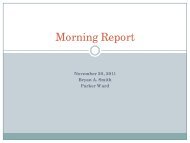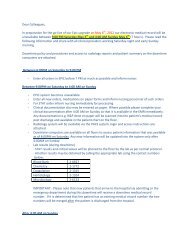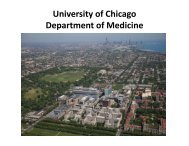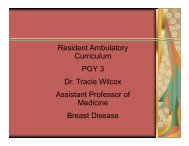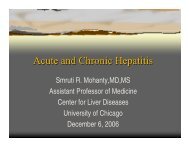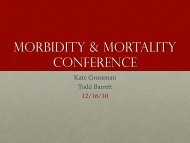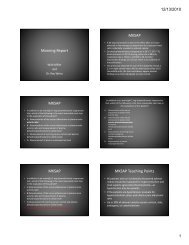Clinical Skills - Peripheral Blood Smear 9.16.10
Clinical Skills - Peripheral Blood Smear 9.16.10
Clinical Skills - Peripheral Blood Smear 9.16.10
Create successful ePaper yourself
Turn your PDF publications into a flip-book with our unique Google optimized e-Paper software.
AFTERNOON DELIGHT<br />
<strong>Peripheral</strong> <strong>Blood</strong> <strong>Smear</strong><br />
September 16, 2010
How do I review a smear?<br />
Go to the Basement of Mitchell Hematology lab<br />
<strong>Smear</strong>s are saved and organized by last name<br />
Look under the microscope
Nucleated RBC = erythroblast<br />
Reticulocyte<br />
It takes t k 24 h t to b become a mature t erythrocyte th t<br />
Normal life span=120 days<br />
A d & b l RBC d d b l i<br />
Aged & abnormal RBCs are destroyed by splenic<br />
macrophages
Normal<br />
1 1. Anisocytosis A i i<br />
(Size): normal<br />
RBC is 2/3 the<br />
size of a mature<br />
lymphocyte<br />
2 2. Pallor: P ll<br />
normally 1/3 of<br />
the RBC.<br />
Indicates the<br />
hemoglobin<br />
content<br />
3. Poikilocytosis<br />
y<br />
(Shape): normal RBC<br />
has biconcave shape
32 yo y F with heavy y pperiods & pica p<br />
Microcytosis Mcocyoss<br />
Hypochromia
Hemoglobin = heme + globin chains<br />
Heme is synthesized from iron and protoporphyrin<br />
Reduced iron causes decreased heme synthesis<br />
Hypochromia and microcytosis occur because of less<br />
hemoglobin content in each RBC
Other Microcytic y anemias<br />
Anemia of Chronic Disease<br />
Thalassemias – defect of globin chains<br />
Sideroblastic anemia anemia- defective heme synthesis<br />
within the mitochondria<br />
Lead poisoning<br />
Vitamin B6 deficiency (pyridoxine)
Lead poisoning p g<br />
Microcytosis &<br />
hypochromic:<br />
Lead denatures heme<br />
synthase th enzyme<br />
(ferrochelatase)<br />
preventing heme<br />
synthesis<br />
Basophilic stippling:<br />
Lead denatures<br />
ribonuclease so<br />
ribosomes persist in the<br />
cytoplasm
62 yo M diabetic with fatigue on metformin<br />
Macrocytic<br />
Hyperchromic<br />
ovalocytes<br />
Hypersegmented<br />
neutrophils<br />
for several years
B12 & folate are coenzymes of DNA synthesis<br />
Deficiencies cause inadequate DNA synthesis and<br />
defective nuclear maturation<br />
RBC nuclei fail to mature and remain large while the<br />
cytoplasm matures and hemoglobin accumulates<br />
RBC precursors are large with prominent nucleoli and diffuse<br />
chromatin<br />
NNeutrophil t hil maturation t ti i is also l affected ff t d<br />
This causes neutrophils to have more nuclear lobes
Macrocytic – due to large immature nucleus<br />
Hyperchromic – larger cell with ample hemoglobin<br />
Hypersegmented neutrophils immature<br />
Hypersegmented neutrophils - immature<br />
granulocytes with additional lobes
Other Macrocytic y anemias<br />
Liver disease<br />
Chronic Alcoholism<br />
MDS<br />
All lack hypersegmented neutrophils
Myelodysplastic y y p Syndrome y (MDS) ( )<br />
Macrocytic y but also<br />
dimorphic with<br />
microcytes y<br />
HHyperchromic h i and d<br />
hypochromic<br />
Hypogranular and<br />
hypolobulated<br />
neutrophils<br />
Pappenheimer<br />
bodies
15 yo F with anemia. Her siblings and<br />
father also have history of anemia anemia.<br />
Osmotic Fragility Test can aid diagnosis<br />
Spherocyte has loss<br />
of central pallor<br />
and smaller size<br />
Autosomal<br />
Dominant<br />
inheritance of RBC<br />
cytoskelatal y<br />
protein deficiency
HS pathophysiology<br />
p p y gy<br />
Deficiency of Skeletal<br />
membrane proteins :<br />
spectrin & ankyrin<br />
Membrane<br />
instability<br />
Fragments of<br />
membrane lost<br />
with age<br />
Cell must form shape<br />
with smallest volume<br />
due to dec’d surface<br />
area to volume ratio<br />
Spherocytes are<br />
less flexible than<br />
normal RBCs<br />
RBC lifespan in HS is 10-20 days<br />
They get trapped in the<br />
splenic cords and<br />
phagocytosed
40 yo y F with SLE and anemia.<br />
Spherocytes p y<br />
Coombs Test (DAT) will<br />
Help in diagnosis<br />
Antibody mediated complement activation leads to phagocytosis of RBCs by<br />
macrophages.
35 yo y M with jjaundice<br />
after Bactrim<br />
“Bite” cells<br />
(keratocytes) are<br />
idi indicative i of f oxidant id<br />
damage<br />
G6PD oxidizes hemoglobin. If there is a deficiency hemoglobin is not<br />
oxidized and precipitates as a Heinz body body. Macrophages remove these<br />
by taking a “bite” out of the RBC.
22 yo y M ppresents with “pain p crisis”<br />
Sickle cells:<br />
HbS molecules<br />
aggregate and<br />
polymerize<br />
Nucleated RBCs and<br />
Reticulocytes<br />
Point MMutation of f Beta-globin chain of f hemoglobin: valine replaces glutamate
Reticulocytes y revisited<br />
Reticulocytes are larger<br />
and have blue-red<br />
polychromatophilic<br />
cytoplasm
Homozygous yg Hemoglobin g C disease<br />
Target cells<br />
Boat cells:<br />
Hemoglobin crystals<br />
seen with hemoglobin g<br />
C molecule only
Target g cells<br />
Cells with excess RBC membrane that bulges in the<br />
center of the cell<br />
Occurs because of red cell dehydration<br />
Repeated sickling causes dehydration<br />
Repeated derangement in membrane structure induces<br />
cross linking of membrane proteins<br />
This activates an ion channel that allows H20 efflux
Causes of Target g Cells<br />
Liver disease – increased membrane cholesterol<br />
Alcohol Abuse- cell dehydration<br />
Hemoglobin SC disease<br />
Homozygous Hemoglobin C disease<br />
Th Thalassemias<br />
l i
Hemoglobin g SC<br />
Target cells and boat<br />
cells<br />
Hemoglobin SC<br />
poikilocytes
40 yo y M s/p /p splenectomy p y<br />
Nucleated RBCs<br />
Howell Jolly Bodies
What are Howell Jolly y Bodies?<br />
Nuclear remnants in an old RBC<br />
Normally these abnormal and aged RBCs are<br />
removed by macrophages in the spleen<br />
Presence indicates no impaired splenic function<br />
Can be seen in SCD with autosplenectomy
82 yo M with sepsis, thrombocytopenia and<br />
elevated INR<br />
Schistocyte, Red<br />
cell fragments and<br />
helmet cells<br />
Indicates destruction within the vascular space (microangiopathic hemolytic anemia).<br />
Seen in TTP, DIC or a defective prosthetic heart valve.
90 yo y F with ppancytopenia y p<br />
Tear drop cells<br />
Seen when extramedullary hematopoiesis is occuring. As in primary<br />
myelofibrosis and thalassemias.
67 yo M with anemia, protein gap and<br />
Rouleux<br />
formation<br />
bone pain<br />
Caused by increased concentration of fibrinogen globulin or paraproteins<br />
Caused by increased concentration of fibrinogen, globulin, or paraproteins.<br />
Associated with acute and chronic inflammatory disorders, Waldenstrom’s<br />
macroglobulinemia, and multiple myeloma
White <strong>Blood</strong> Cells
Differential of eosinophilia p<br />
Parasitic infections<br />
Drugs<br />
Hypersensitivity reactions<br />
Pulmonary diseases (asthma, eosinophilic PNA, etc)<br />
MMyeloproliferative l lif i di diseases
22 yo college student with sore throat and fatigue x 2<br />
weeks k at t Saturday S t d UC
61 yo M pmh Hodgkin’s Lymphoma s/p<br />
chemotherapy with epistaxis and fever<br />
Blasts<br />
Auer Rod
50 yo y F with malaise and leukocytosis y
72 yo M with WBC count of 50,000 and<br />
splenomegaly<br />
Smudge cell<br />
Cells that are flattened while the slide is made Due to fragility of the cells<br />
Cells that are flattened while the slide is made. Due to fragility of the cells<br />
upon manipulation.
References<br />
Images from library.med.utah.edu/WebPath &<br />
Robbins atlas<br />
Bain, B. Diagnosis from the <strong>Blood</strong> <strong>Smear</strong>. N Engl J<br />
Med 2005;353:498-507.<br />
Robbins pathology



